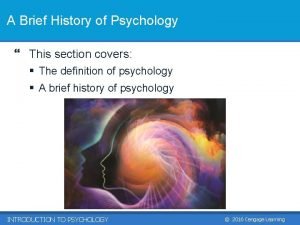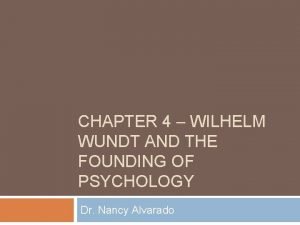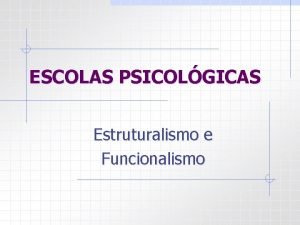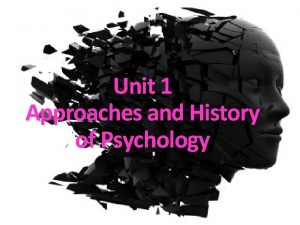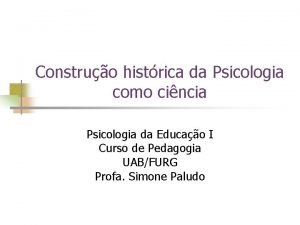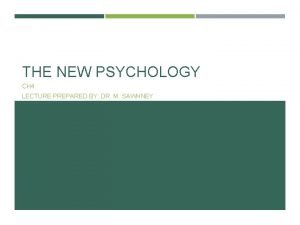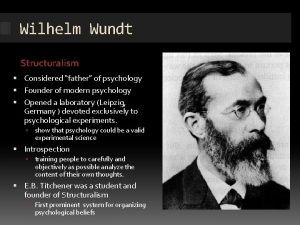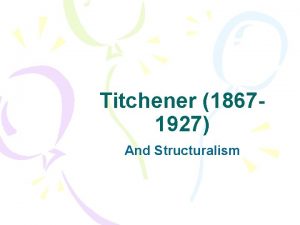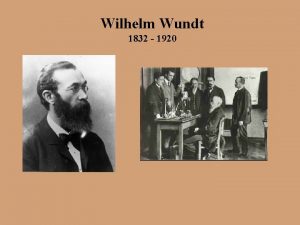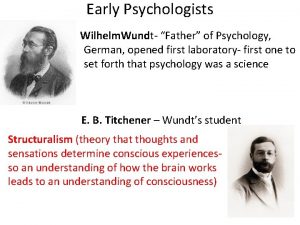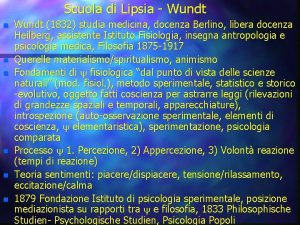Structuralism in Psychology Founders of Structuralism Wilhelm Wundt









- Slides: 9

Structuralism in Psychology

Founders of Structuralism Wilhelm Wundt � Considered the “Father of Psychology” � Established first Psychology Lab in Germany in 1879 � Formed basic ideas on structuralism

Founders of Structuralism Edward B. Titchener � Studied under Wundt, and expanded upon Wundt's ideas to found theory of structuralism. � Introduced Wundt’s ideas to America

What is Structuralism? �Structuralism is generally thought of as the first school of thought in psychology. It is theory that the structure of conscious experience could be understood by analyzing the basic elements of thoughts and sensations. �It attempted to understand the mind as the sum of varying underlying parts, classifying the structures of the mind much like chemists classify the elements of nature into the periodic table. These elements would include ideas like sensations, emotions, and images. �The focus of structuralism was on reducing mental processes down into their most basic elements. Structuralists used techniques such as introspection to analyze the inner processes of the human mind.

Introspection �The main technique that was used to try and determine the different components of consciousness was introspection. Or the observation & recording of one’s own subjective experience.

Titchener’s Method � Titchener trained his students to become skilled at trained introspection – to report only the sensations as they were experienced without reliance on “meaning words” – he called this stimulus error. � Using this approach, Titchener’s students reported various visual, auditory, tactile, etc experiences: � In “An Outline of Psychology” (1896), he reported over 44, 000 elements of sensation: • 32, 820 Visual, • 11, 600 Auditory, • 4 Taste, etc.

Elements of Consciousness �Titchener proposed 3 elementary states of consciousness: Sensations: � basic elements of perception – sights, sounds, tastes, smells etc. Evoked by physical objects in the environment Images: � elements of ideas – reflects experiences not actually present at that time, e. g. memory of a sight. Affections: � feelings – the elements of emotion: love, hate, anger, sadness etc.

Characteristics of the Elements � Claimed that elements could be distinguished by: � Quality – “cold” or “red”: distinguishes each element from the others � Intensity – how strong, loud, bright etc. the sensation is � Duration – course of a sensation over time; how long it lasts � Clearness – role of attention in consciousness – clearer if attention is directed toward it *Later he identified them as: quality, intensity, duration, attensity (clearness) & extensity

Criticisms and the Decline of Structuralism � Over the years his approach using introspection became more rigid and limited. � By today’s scientific standards, the experimental methods used to study the structures of the mind were too subjective; the use of introspection led to a lack of reliability in results. � Other critics argue that structuralism was too concerned with internal behavior, which is not directly observable and cannot be accurately measured. � Because introspection itself is a conscious process it must interfere with the consciousness it aims to observe � Eventually the idea of introspection became extinct after Titchner’s death.
 History of developmental ideas in psychology
History of developmental ideas in psychology Wilhelm wundt structuralism
Wilhelm wundt structuralism A brief history of psychology
A brief history of psychology Structuralism psychology definition
Structuralism psychology definition Language testing approaches and techniques
Language testing approaches and techniques Wilhelm wundt founded the
Wilhelm wundt founded the Harvey carr funcionalismo
Harvey carr funcionalismo Approaches to psychology
Approaches to psychology Lei do efeito thorndike
Lei do efeito thorndike Structuralism in psychology
Structuralism in psychology


